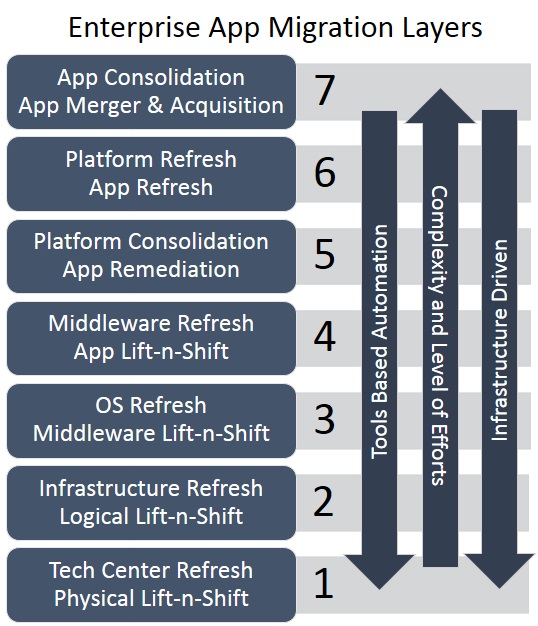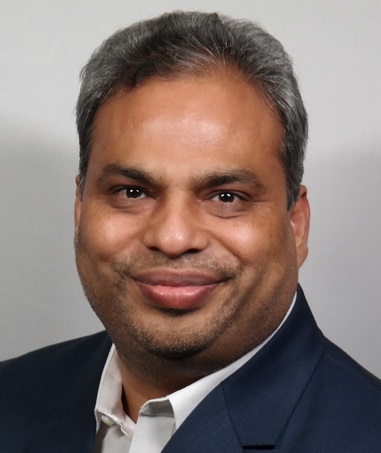14/01: Enterprise App Migration Layers and Approaches
Category: Best Practices
Posted by: bagheljas
Change is inevitable for an enterprise application life cycle. The change for an enterprise application comes in various forms and the most common words used for the application changes are migration, transition, transformation, upgrades and consolidation. The diagram below creates a layered architecture for an enterprise application changes named as Enterprise App Migration Layers. The Enterprise App Migration Layered Architecture provides a cross industry standard approaches for application migration needs.

It is leading practice to limit number of layers changing for a given migration event to keep the migration simple as much as possible. In contrary, you get economies of scope benefits to combine the changes in multiple layers. Therefore, selecting changes for a migration event is an art and science that needs to combine with the capabilities, refresh requirements (usually driven around app platform components end of life timelines), timeline objectives and cross functional resources availability.

It is leading practice to limit number of layers changing for a given migration event to keep the migration simple as much as possible. In contrary, you get economies of scope benefits to combine the changes in multiple layers. Therefore, selecting changes for a migration event is an art and science that needs to combine with the capabilities, refresh requirements (usually driven around app platform components end of life timelines), timeline objectives and cross functional resources availability.
- 7. App Consolidation - App Merger & Acquisition: When an enterprise have more then two applications serving one functional domain that either applications is capable to serve functional users. In this case, enterprise architect often port less desired application stack to the most desired application stack. On the other hand, if a functional domain is matured and common in industry that has an economical Cloud Computing Software as a Service (SaaS) provider(s) that meets your functional, performance and security requirements. An enterprise architect may consider to migrate to a SaaS provider. It is a leading practice to develop and execute comprehensive testing plan with multiple domains such as features, system, integration, security, performance, backup & disaster recovery and user acceptance. This layer migration usually driven by top down enterprise IT strategy with or without cloud.
- 6. Platform Refresh - App Refresh: You are refreshing application COTS product to latest version or adding new components for new features either on existing or latest versions of underlying technology stack. The migration is manual in nature but one may consider build automation. It is a leading practice to develop and execute testing plan in domains such as features, system, integration, and user acceptance.
- 5. Platform Consolidation - App Remediation: You are retaining application COTS product version and functionality but porting underlying technology stack to desired vendors to comply with enterprise architecture mandates such as DB2 to Oracle, WebLogic to Tomcat, IIS to Apache etc. The migration is manual in nature but one may consider build automation. The most common type of migration when an enterprise is looking to eliminate expensive technology components from the enterprise technology portfolio or migrating to Public Cloud Computing - Infrastructure as a Service (IaaS) provider. It is a leading practice to develop and execute testing plan in domains such as features, system, performance, integration, and user acceptance.
- 4. Middleware Refresh - App Lift-n-Shift: You are retaining application COTS product version and functionality but upgrading the underlying middleware technologies to latest version such as Oracle DB, WebLogic AS and Apache WS. The migration is manual in nature but one may consider build automation. It is a leading practice to develop and execute testing plan in domains such as system, security, performance, integration, and user acceptance.
- 3. OS Refresh - Middleware Lift-n-Shift: You are upgrading versions of underlying operating system or migrating to an standardize operating system image of existing version. One may consider tools like AppZero or manual transformation. The most common migration type when an enterprise is changing and/or outsourcing to managed hosting provider. It is a leading practice to develop and execute testing plan in domains such as system, security, integration, and user acceptance.
- 2. Infrastructure Refresh - Logical Lift-n-Shift: You are refreshing server hardware platform only. It is a leading practice to leverage tools to perform Logical Lift-n-Shift migration. The industry leading tools for such migration are PlateSpin Migrate, Rackware, VMWare Tools, and Data Gardens. It is common to hear the terms like P2P, P2V, V2P and V2V migrations for this kind of exercise. The most common migration type when you are migrating to Cloud Computing - Infrastructure as a Service (IaaS) provider.It is a leading practice to develop and execute testing plan in domains such as system, security, performance, integration, and user acceptance.
- 1. Tech Center Refresh - Physical Lift-n-Shift: You are either moving from on-premise data center to colocation or changing colocation provider only. It is a leading practice to develop and execute testing plan in domains such as integration, and user acceptance.
Disclaimer
The thoughts expressed in the blog are those of the author and do not represent necessarily the official policy or position of any other agency, organization, employer, or company. Assumptions made in the study are not reflective of the point of view(s) of any entity other than the author. Since we are critically thinking human beings, the point of view(s) is always subject to change, revision and rethinking at any time. While reasonable efforts have been made to obtain accurate information, the author makes no warranty, expressed or implied as to its accuracy.
The thoughts expressed in the blog are those of the author and do not represent necessarily the official policy or position of any other agency, organization, employer, or company. Assumptions made in the study are not reflective of the point of view(s) of any entity other than the author. Since we are critically thinking human beings, the point of view(s) is always subject to change, revision and rethinking at any time. While reasonable efforts have been made to obtain accurate information, the author makes no warranty, expressed or implied as to its accuracy.
